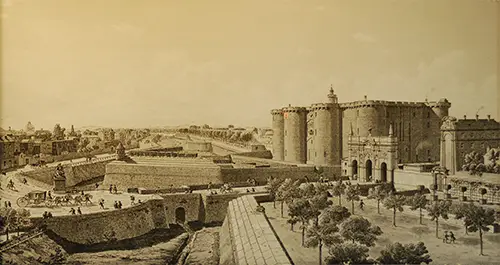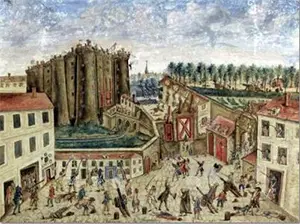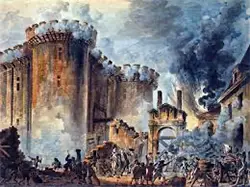The Storming of the Bastille
It was midway through the morning of July 14, 1789, that a group of 1,000 discontented French people gathered at the Bastille, determined to seize it. 
The Bastille was, at the time, a prison. It hadn't always been such. The fortress, dominated by eight 78-foot-tall towers, owed its construction to the Hundred Years War and became a prison in 1417. The Bastille had been taken before, in 1420, by English soldiers led by King Henry V. Thomas Beaufort, Duke of Exeter became captain of the fortress, and the English maintained its function as a prison. A brief seizure by Burgundians in 1464 rounded out the very slim number of months and year during which French soldiers did not patrol the Bastille. Catholic forces used the fortress as a base of operations during the 16th-Century Wars of Religion. Historians generally regard Cardinal Richelieu, chief minister to King Louis XIII, as the force behind using the Bastille as a prison for enemies of the state. And so it functioned through the 17th and 18th Centuries, serving as a symbol of governmental power and, in the case of Louis XIV, King Louis XV, and King Louis XVI, absolute monarchy. Adding to the discontent of many people in France in the late 18th Century was the introduction of state imprisonment stemming from charges of writing and distributing libelous and seditious books. The noted philosophe Voltaire spent time in the Bastille for writings that the Catholic Church–and, by extension, the Crown–deemed heretical. As late as 1774, Jacques Necker, the Director-General of France, had recommended closing the Bastille in order to save money. By that time, the number of prisoners kept there had dropped by quite a lot. In 1782, only 10 prisoners remained. On July 14, 1789, that number had dropped to seven. It wasn't the release of prisoners that the several hundred people who had gathered at the Bastille that morning were after; rather, they wanted the weapons stored inside. The Bastille was still a federal garrison, guarded by federal troops. A revolutionary mood had already taken hold in Paris. A handful of poor harvests in recent years had depleted stocks of grain, and bread vendors had raised their prices. A great many could afford very little; all the while, the king and queen and other royals continued their freespending ways. Class tension had been bubbling away for years as it was, and a large number of people had finally had enough. King Louis XVI had called the Estates-General, which had broken apart when the commoners who made up the Third Estate walked out and set up their own representative body, National Assembly, and demanded a constitution. The king recognized the political will of that organization, which, after being joined by clergy and nobles, became the National Constituent Assembly. In the meantime, Necker, the finance minister, had published the royal financial accounts and the king had, in turn, removed Necker, who was much favored by people from all three Estates, from his position. Public demonstrations on July 12 championed Necker for revealing the king's profligacy. The next day, public gatherings turned violent. 
The violence continued on July 14. Armed protesters had stormed a nearby administrative center, in hopes of obtaining weapons and gunpowder; as it happened, officials there had just a few days before moved their store of 250 barrels of gunpowder to the Bastille. Defending the Bastille were slightly more than 100 soldiers and 30 guns, 18 of which were cannons. The group gathered outside the prison demanded the surrender of the soldiers, their guns and ammunition, and the prison itself. Governor Bernard-René de Launay refused. Negotiations broke out and came to nothing. A few bouts of sporadic gunfire later, the protesters had broken the chains on the drawbridge and stormed into the outer courtyard. Behind the inner gate was the governor, who proposed a cease-fire. At 5:30 p.m., soldiers opened the inner gate and the protesters flooded in, taking control of soldiers, weapons, and the fortress itself, liberating the seven prisoners in the process. 
At no time did the 5,000 Royal Army stationed nearby enter the fray. It was troop movements that sparked the protesters, fearing a crackdown, into more violent action in the first place. The death toll was 103. Only five of those were soldiers: One was the governor, who was killed by the protesters after an angry debate over his fate; one died in the initial fighting; the last were garrison officers killed by the protesters after the fortress had been secured. The following day, the Marquis de Lafayette, who had fought with distinction in the American Revolutionary War, assumed command of the National Guard. In the days that followed, more and more members of the nobility, including the future King Charles X, fled the country. Angry Parisians began dismantling the mighty fortress. |
|
Social Studies for Kids
copyright 2002–2024
David White




